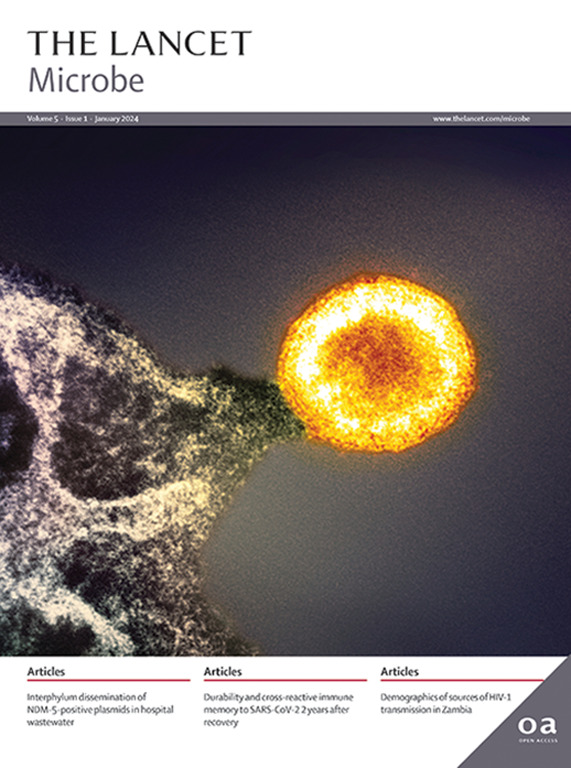Mapping of human monoclonal antibody responses to XBB.1.5 COVID-19 monovalent vaccines: a B cell analysis
IF 20.4
1区 生物学
Q1 INFECTIOUS DISEASES
引用次数: 0
Abstract
Background
The rapid emergence of highly transmissible and immune-evasive SARS-CoV-2 variants has required the reformulation of COVID-19 vaccines to target these evolving threats. Although previous infections and booster vaccinations can boost variant neutralisation, it remains uncertain whether monovalent vaccines—delivered via mRNA or protein-based platforms—can trigger novel B-cell responses specific to omicron XBB.1.5 variants. We sought to address this uncertainty by characterising the antibody repertoire of individuals receiving a monovalent booster vaccine.
Methods
In this observational study, we analysed the genetic antibody repertoire of 603 individual plasmablasts from five individuals (recruited at the Icahn School of Medicine at Mount Sinai, New York, NY, USA, from STUDY-16-01215/IRB-16-00971 and STUDY-20-00442/IRB-20-03374) vaccinated with a monovalent XBB.1.5 vaccine, either through mRNA (Moderna or Pfizer–BioNTech; participants 1, 2, and 3) or adjuvanted protein (Novavax; participants 4 and 5) platforms. Before XBB.1.5 booster vaccination, all participants received mRNA-based priming and booster vaccine with ancestral SARS-CoV-2 and four of the five participants had a breakthrough omicron variant infection. We expressed 100 human monoclonal antibodies (mAbs; 50 from participants 1, 2, and 3, and 50 from participants 4 and 5) and evaluated their binding and neutralisation against various SARS-CoV-2 variants, including JN.1. We then selected four mAbs for in-vivo protection experiments by passive immunisation and viral challenge, and cryo-electron microscopy with two selected mAbs complexed with the XBB.1.5 spike (S) protein to determine their structures and binding interactions.
Findings
Between October and November, 2023, we enrolled three male and two female participants (mean age 46 years) all of whom were White. We identified 21 binding mAbs and tested their neutralisation capacity against ancestral SARS-CoV-2, XBB.1.5, and JN.1. From the six neutralising mAbs we characterised, we selected three (M2, M27, and M39) for in-vivo protection studies, along with one broadly binding antibody (M15), finding that three neutralising mAbs offered full protection against morbidity from XBB.1.5. M27 also displayed robust protection against the ancestral and JN.1 strains, and M39 offered partial protection from JN.1. Among these, we identified two standout antibodies: M2 and M39. M2 was uniquely specific to XBB.1.5, and M39 demonstrated the ability to bind and neutralise both XBB.1.5 and JN.1 strains. Using high-resolution cryo-electron microscopy, we mapped the binding sites of M2 and M39 on the XBB.1.5 S glycoprotein, uncovering the precise molecular interactions that dictate their specificity.
Interpretation
Our findings offer key molecular insights into whether strain-specific boosters elicit sufficient protection against SARS-CoV-2 emerging variants. This knowledge can inform decisions on booster design and strategies to enhance preparedness to evolving viral threats.
Funding
Icahn School of Medicine at Mount Sinai; National Institutes of Health (NIH) FIRST; Laura and Isaac Perlmutter Cancer Center Support Grant; National Institute of Allergy and Infectious Diseases; Human Immunology Project Consortium by NIH; the São Paulo Research Foundation; the National Heart, Lung, and Blood Institute of the NIH; Irma T Hirschl and Monique Weill-Caulier Trust; and the Collaborative Influenza Vaccine Innovation Centers.
人单克隆抗体对XBB.1.5 COVID-19单价疫苗反应的定位:B细胞分析
背景:高传染性和免疫逃避性SARS-CoV-2变体的迅速出现要求重新配制COVID-19疫苗以针对这些不断演变的威胁。虽然先前的感染和加强疫苗接种可以促进变异中和,但单价疫苗(通过mRNA或基于蛋白质的平台递送)是否可以触发对组微米XBB.1.5变异特异性的新b细胞反应仍不确定。我们试图通过描述接受单价加强疫苗的个体的抗体库来解决这种不确定性。方法:在这项观察性研究中,我们分析了来自5名接种单价XBB.1.5疫苗的个体(来自美国纽约西奈山伊坎医学院,来自study -16-01215/IRB-16-00971和study -20-00442/IRB-20-03374)的603个个体的质母细胞的遗传抗体库,这些个体通过mRNA (Moderna或辉瑞- biontech;受试者1、2和3)或佐剂蛋白(Novavax;参与者4和5)平台。在接种XBB.1.5加强疫苗前,所有参与者均接种了基于mrna的引物和祖传SARS-CoV-2加强疫苗,5名参与者中有4名出现突破性组粒变异感染。我们表达了100个人单克隆抗体(mab;50例来自受试者1、2和3,50例来自受试者4和5),并评估它们对各种SARS-CoV-2变体(包括JN.1)的结合和中和作用。然后,我们选择了4个单抗进行被动免疫和病毒攻击的体内保护实验,并将选择的2个单抗与XBB.1.5 spike (S)蛋白复合物进行低温电子显微镜观察,以确定它们的结构和结合相互作用。研究结果:在2023年10月至11月期间,我们招募了三名男性和两名女性参与者(平均年龄46岁),他们都是白人。我们鉴定了21种结合单克隆抗体,并测试了它们对祖先SARS-CoV-2、XBB.1.5和JN.1的中和能力。从我们鉴定的六种中和性单克隆抗体中,我们选择了三种(M2、M27和M39)进行体内保护研究,以及一种广泛结合抗体(M15),发现三种中和性单克隆抗体对XBB.1.5的发病率提供全面保护。M27对祖先株和JN.1株具有较强的保护作用,而M39对JN.1株具有部分保护作用。其中,我们鉴定出两种突出的抗体:M2和M39。M2对XBB.1.5具有特异性,而M39具有结合和中和XBB.1.5和JN.1菌株的能力。利用高分辨率低温电子显微镜,我们绘制了M2和M39在XBB.1.5 S糖蛋白上的结合位点,揭示了决定它们特异性的精确分子相互作用。解释:我们的研究结果为菌株特异性增强剂是否能对SARS-CoV-2新变体产生足够的保护提供了关键的分子见解。这方面的知识可以为加强对不断演变的病毒威胁的准备工作的助推器设计和战略决策提供信息。资助:西奈山伊坎医学院;美国国立卫生研究院(NIH)第一;劳拉和艾萨克·珀尔马特癌症中心支持基金;国家过敏和传染病研究所;美国国立卫生研究院人类免疫学项目联盟;圣保罗研究基金会;美国国立卫生研究院的国家心脏、肺和血液研究所;Irma T Hirschl和Monique Weill-Caulier Trust;以及流感疫苗创新合作中心。
本文章由计算机程序翻译,如有差异,请以英文原文为准。
求助全文
约1分钟内获得全文
求助全文
来源期刊

Lancet Microbe
Multiple-
CiteScore
27.20
自引率
0.80%
发文量
278
审稿时长
6 weeks
期刊介绍:
The Lancet Microbe is a gold open access journal committed to publishing content relevant to clinical microbiologists worldwide, with a focus on studies that advance clinical understanding, challenge the status quo, and advocate change in health policy.
 求助内容:
求助内容: 应助结果提醒方式:
应助结果提醒方式:


